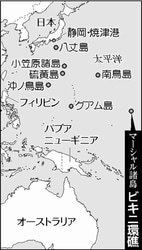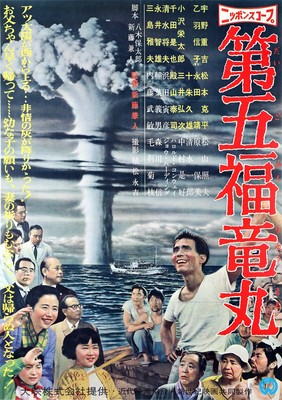How an Anti-Nuclear Film was Made
In March 1954, the crew of the Japanese fishing boat Daigo Fukuryumaru was exposed to strong radiation caused by a US hydrogen bomb test in the southern Pacific Ocean.
Eventually, one of 23 crews of the fishing vessel died of radioactive disease in September 1954. This incident was widely reported not only in Japan but also globally, and the world became aware of danger of the US thermonuclear device test being conducted on Bikini Atoll.
However, the Japanese Government did not take a stern attitude to the US. As the US Government paid $2 million as consolation payment to victims in 1955, Tokyo stopped protest to Washington, while the US Government never officially apologized. The Japanese Government did not want to rouse the Japanese people to blame the US that inflicted nuclear damage to Japanese again, in addition to the use of atomic bombs in Hiroshima and Nagasaki in WWII. Tokyo wanted to keep good relationships with Washington for economic interest and in prospect of obtaining nuclear energy technology from the US in the future.
Accordingly the general public of Japan gradually forgot the Daigo Fukuryumaru Incident. However, there was a film director in Japan who wanted to handle this incident in his work.
Lucky Dragon No. 5 (Daigo Fukuryu Maru) is a 1959 Japanese film directed by Kaneto Shindo (1912-2012). It is based on the story of the Daigo Fukuryū Maru.
An ageing fishing boat, Dai-go Fukuryū Maru ("Lucky Dragon No. 5") sets out from the port of Yaizu in Shizuoka Prefecture. It travels around the Pacific, line fishing. While the ship is near Bikini Atoll, the ship's navigator sees a flash. All the crew come up to watch. They realize it is an atomic explosion, but take the time to clear their fishing gear. A short time later, grey ash starts to fall on the ship. By the time the ship returns to port, the sailors have been burned brown. They unload the fish, which are then transported away. They visit the local doctor and then go to Tokyo for an examination. It turns out they are all highly radioactive. Their symptoms become worse, and the contaminated fish causes a panic. The men are taken to hospitals in Tokyo, leaving their families behind. The radio operator, Kuboyama (Jūkichi Uno), dies from the radiation.
https://en.wikipedia.org/wiki/Lucky_Dragon_No._5_(film)
Film director Shindo was at the time a member of an independent film making organization. He did not belong to any movie companies. Therefore, he had not enough money. But, as he had already made a film on Hiroshima, Shindo was strongly motivated to handle this nuclear disaster.
Shindo and his crew visited and stayed in the port town Yaizu, 200 km west of Tokyo, for taking pictures. But their budget was depleted. They found they had no more money to pay accommodation charges to a Japanese-style inn where they were staying. But the owner of the inn cooperated with Shindo, allowing them to stay till their shootings were over. And finally, Shindo and the crew left Yaizu, just promising they would pay the charge some time in future.
But, this film Daigo Fukuryu Maru was not accepted widely in Japan. People wanted to forget about the tragedy. Japan was entering an era of high economic growth by mainly exporting goods to the US market. So, it was mainly leftist people that praised this film. This film could nolt achieve even reasonable financial success. Shindo could not pay debts to the inn in Yaizu.
Director Shindo thought that his ambition to run an independent film-making organization failed. But he wanted to make another one as the last trial. It was The Naked Island (Hadaka no shima), released in 1960, though it had nothing to do with nuclear disasters. It was made with the least amount of budget Shindo had ever used. However, this film was highly appreciated overseas. Shindo could sell performance rights to foreign agents at reasonable prices.
And then Shindo visited Yaizu to pay the debts to the inn owner. The owner was surprised and could not easily believe that Shindo and his poor crew could produce a great hit.
In March 2011, an M9.0 earthquake occurred in the Pacific off the northeast part of the Japanese mainland. It triggered great tsunamis that in turn triggered the Fukushima Daiichi Nuclear accident. Some Japanese facing a threat of radiation exposure recalled the film Daigo Fukuryu Maru, though Shindo died next year after making his last film, which was an anti-war story, in 2011. Kaneto Shindo was 98 year old when he made his last film, making him the oldest film director in the world.
The wooden ship Daigo Fukuryumaru is today exhibited on Tokyo Bay, though you may purchase the DVD of Daigo Fukuryu Maru through a vendor.

http://www.soko-net.jp/mt/archives/2005/05/post_54.html

http://members.jcom.home.ne.jp/hana-2/Fukuryu-maru.htm

Bikini Atoll east of Guam
http://www.jcp.or.jp/akahata/aik10/2011-02-28/2011022805_01_0.html

Film Poster of Daigo Fukuryu Maru (a black-and-white movie)
http://poster.blog.so-net.ne.jp/2010-04-11-34
**** **** ****
Mat 8:3 And Jesus put forth his hand, and touched him, saying, I will; be thou clean. And immediately his leprosy was cleansed.

